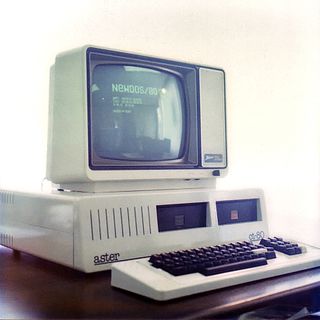
The Aster CT-80 is a 1982 personal computer developed by the small Dutch company MCP, was sold in its first incarnation as a kit for hobbyists. Later it was sold ready to use. It consisted of several Eurocard PCB's with DIN 41612 connectors, and a backplane all based on a 19-inch rack configuration. It was the first commercially available Dutch personal/home computer. The Aster computer could use the software written for the popular Tandy TRS-80 computer while fixing many of the problems of that computer, but it could also run CP/M software, with a large amount of free memory Transient Program Area, (TPA) and a full 80×25 display, and it could be used as a Videotext terminal. Although the Aster was a clone of the TRS-80 Model I it was in fact more compatible with the TRS-80 Model III and ran all the software of these systems including games. It also had a built-in speaker which was compatible with such games software.

The TRS-80 Micro Computer System is a desktop microcomputer launched in 1977 and sold by Tandy Corporation through their Radio Shack stores. The name is an abbreviation of Tandy Radio Shack, Z80 [microprocessor]. It is one of the earliest mass-produced and mass-marketed retail home computers.

The RadioShack TRS-80 Color Computer, later marketed as the Tandy Color Computer, is a series of home computers developed and sold by Tandy Corporation. Despite sharing a name with the earlier TRS-80, the Color Computer is a completely different system and a radical departure in design based on the Motorola 6809E processor rather than the Zilog Z80 of earlier models.
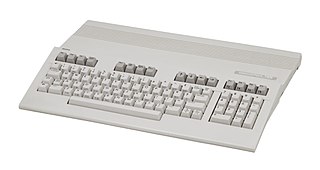
The Commodore 128, also known as the C128, C-128, or C= 128, is the last 8-bit home computer that was commercially released by Commodore Business Machines (CBM). Introduced in January 1985 at the CES in Las Vegas, it appeared three years after its predecessor, the Commodore 64, the bestselling computer of the 1980s. Approximately 2.5 million C128s were sold during its four year production run.
Microsoft BASIC is the foundation software product of the Microsoft company and evolved into a line of BASIC interpreters and compiler(s) adapted for many different microcomputers. It first appeared in 1975 as Altair BASIC, which was the first version of BASIC published by Microsoft as well as the first high-level programming language available for the Altair 8800 microcomputer.
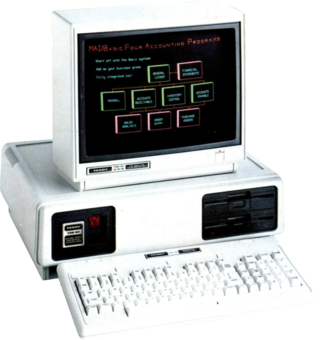
The Tandy 2000 is a personal computer introduced by Radio Shack in September 1983 based on the 8 MHz Intel 80186 microprocessor running MS-DOS. By comparison, the IBM PC XT used the older 4.77 MHz Intel 8088 processor, and the IBM PC/AT would later use the newer 6 MHz Intel 80286. Due to the 16-bit data bus and more efficient instruction decoding of the 80186, the Tandy 2000 ran significantly faster than other PC compatibles, and slightly faster than the PC AT. The Tandy 2000 was the company's first computer built around an Intel x86 series microprocessor; previous models used the Zilog Z80 and Motorola 6809 CPUs.

The Sharp PC-1403 was a small scientific calculator and pocket computer manufactured by Sharp. It was the successor of the Sharp PC-1401, and had better display, more RAM and better system software.

The Sharp PC-1500 was a pocket computer produced by Sharp between 1981 and 1985. A rebadged version was also sold as the TRS-80 Pocket Computer PC-2.

The Sharp PC-1211 is the first pocket computer ever released, marketed by Sharp Corporation in March 1980. The computer was powered by two 4-bit CPUs laid out in power-saving CMOS circuitry. One acted as the main CPU, the other dealt with the input/output and display interface. Users could write computer programs in BASIC.
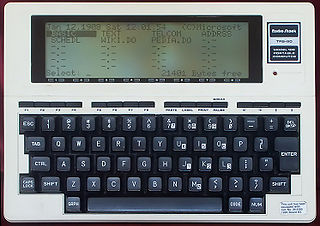
The TRS-80 Model 100 is a notebook-sized portable computer introduced in April 1983.

A pocket computer is a class of handheld computer characterized by very short displays and calculator-style alphanumeric keypads. Pocket computers occupy a small footprint, allowing the unit to be comfortably stashed in one's pocket when on the go, and usually weigh less than 1 pound (0.45 kg). Many feature a port for an expansion chassis, allowing the computers to be used with external peripherals.
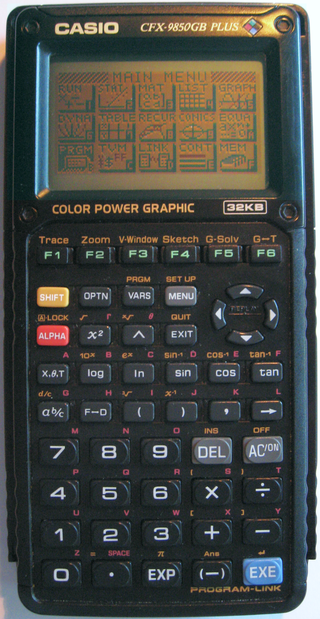
The Casio CFX-9850G series is a series of graphing calculators manufactured by Casio Computer Co., Ltd. from 1996 to 2008.

Scripsit is a word processing application written for the Radio Shack TRS-80 line of computers. Versions were available for most if not all computers sold under the TRS-80 name, including the TRS-80 Color Computer and several pocket computer designs, as well as the Tandy version of the Xenix operating system. Tandy Corp. also produced a version running under MS-DOS for its line of PC compatible computers. Some of the 8-bit versions are tape-based and have no ability to read or write to disk.

The Sharp PC-E500S was a 1995 pocket computer by Sharp Corporation and was the successor to the 1989 PC-E500 model, featuring a 2.304 MHz CMOS CPU.

The TRS-80 Model II is a computer system launched by Tandy in October 1979, and targeted at the small-business market. It is not an upgrade of the original TRS-80 Model I, but a new system.

The FX-702P is a Pocket Computer, manufactured by Casio from 1981 to 1984.
Extended Color Basic is an update to the Color BASIC interpreter for the Radio Shack/Tandy TRS-80 Color Computer series, and is the default Basic interpreter for the Color Computer 2. The Color Computer Basic implementations are somewhat different for the versions of Basic which come with the other family of TRS-80 machines, namely Basic Levels I, II, and III. Assemblers and Pascal and C programming language compilers are available for the different machines in the series. Modified subsets of Color Basic may be found on many of the Radio Shack PC series of pocket computers of the era.
Level I BASIC is a dialect of the BASIC programming language that shipped with the first TRS-80, the TRS-80 Model I.

The Casio Algebra FX series was a line of graphing calculators manufactured by Casio Computer Co., Ltd from 1999 to 2003. They were the successor models to the CFX-9970G, the first Casio calculator with computer algebra system, or CAS, a program for symbolic manipulation of mathematical expressions. The calculators were discontinued and succeeded by the Casio ClassPad 300 in 2003.

















